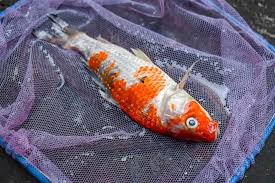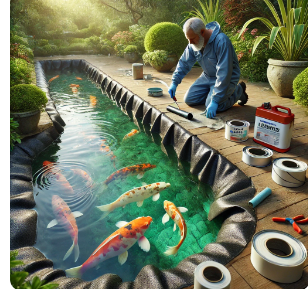Ammonia buildup is one of the biggest threats to koi fish health. High ammonia levels can cause stress, damage gills, and even lead to fish death if not managed properly. If you’re noticing cloudy water, sick fish, or a foul smell in your koi pond, it’s time to take action.
In this guide, we’ll explain what causes ammonia spikes, the dangers of high ammonia levels, and the best ways to reduce ammonia in your koi pond.
What Causes High Ammonia Levels in a Koi Pond?
Ammonia in a pond comes from organic waste. The main sources include:
✔ Fish waste – Koi fish constantly produce waste, which breaks down into ammonia.
✔ Uneaten fish food – Leftover food decomposes, releasing ammonia into the water.
✔ Dead plants or fish – Organic matter rotting in the pond increases ammonia levels.
✔ Overstocking – Too many fish in a small pond creates excess waste.
✔ Poor filtration – Weak or clogged filters fail to remove ammonia efficiently.
✔ Lack of water changes – Stagnant water allows ammonia to accumulate.
If any of these factors apply to your pond, you need to act quickly to prevent ammonia poisoning.
Signs of High Ammonia Levels in a Koi Pond

How do you know if ammonia is too high in your pond? Watch out for these signs:
🔴 Fish gasping for air at the surface
🔴 Red or inflamed gills
🔴 Lethargy or koi rubbing against surfaces (flashing)
🔴 Cloudy or murky water
🔴 Strong, unpleasant odor
🔴 Sudden fish deaths
If you notice any of these warning signs, it’s crucial to test your water immediately and take corrective action.
How to Test Ammonia Levels in Your Koi Pond
The ideal ammonia level for a koi pond is 0 ppm (parts per million). Anything above 0.25 ppm is dangerous.

How to test ammonia in your pond:
1️⃣ Use an ammonia test kit – Available at pet stores or online, these kits give instant readings.
2️⃣ Check daily if you suspect a problem – Especially after adding new fish or during hot weather.
3️⃣ Monitor pH levels – Ammonia is more toxic in high pH water (above 8.0).
If your ammonia levels are high, follow the steps below to bring them down quickly.
How to Reduce Ammonia Levels in a Koi Pond
1. Perform a Partial Water Change
Replacing 10-30% of the pond water will dilute ammonia levels immediately.
📌 Steps to follow:
✔ Use dechlorinated water (chlorine kills beneficial bacteria).
✔ Match the temperature of new and old water to avoid shocking koi.
✔ Perform regular water changes (10-20% per week) to maintain balance.
🚨 Avoid changing too much water at once, as it can remove beneficial bacteria.
2. Remove Uneaten Food & Organic Waste

Excess food and decaying matter fuel ammonia production.
📌 What to do:
✔ Feed koi only what they can eat in 2-3 minutes.
✔ Use a skimmer net to remove uneaten food.
✔ Clean out dead leaves, algae, and fish waste regularly.
Pro Tip: Reduce feeding when ammonia levels are high to prevent further buildup.
3. Improve Biological Filtration
Beneficial bacteria break down ammonia into harmless nitrates. If your pond lacks proper filtration, ammonia will spike quickly.
📌 Solutions:
✔ Add a biological filter – Biofilters support good bacteria to neutralize ammonia.
✔ Use filter media with high surface area (ceramic rings, bio-balls, or lava rock).
✔ Avoid overcleaning your filter – Rinse in pond water, not tap water, to preserve bacteria.
🚨 Warning: If you recently cleaned or replaced your filter, beneficial bacteria may have been lost, leading to ammonia spikes.
4. Use Beneficial Bacteria Supplements
Adding beneficial bacteria speeds up ammonia breakdown, especially in new or struggling ponds.
📌 Best products:
✔ API Pond-Zyme
✔ Microbe-Lift Nite-Out
✔ Seachem Stability
How to use: Follow the product instructions, adding bacteria weekly or after a water change.
5. Increase Aeration & Oxygen Levels
More oxygen means better ammonia breakdown and healthier koi.
📌 How to boost oxygen:
✔ Install an air pump or fountain to increase surface movement.
✔ Use a waterfall or aerator to keep water circulating.
✔ Add live plants (like water hyacinth) to produce oxygen naturally.
💡 Did you know? Warm water holds less oxygen, making ammonia more toxic in summer!
6. Use Ammonia Neutralizers (Short-Term Fix)
If ammonia levels are dangerously high, use an ammonia detoxifier to make it safe for fish.
📌 Best ammonia removers:
✔ Seachem Prime
✔ API Ammo-Lock
✔ Kordon AmQuel+
🚨 Important: These products don’t remove ammonia, they just make it non-toxic. You’ll still need to address the root cause.
7. Reduce Fish Stocking Density

Too many koi in a small pond = ammonia overload.
📌 Stocking recommendations:
✔ One koi per 250 gallons of water for proper balance.
✔ Avoid adding too many fish at once – beneficial bacteria need time to adjust.
If your pond is overcrowded, consider rehoming some koi or upgrading to a larger pond.
Preventing Future Ammonia Spikes
To keep ammonia under control, follow these best practices:
✔ Test water weekly – Catch problems early before they harm your fish.
✔ Clean your pond regularly – Remove debris and check filters.
✔ Feed koi wisely – Overfeeding = more waste = more ammonia.
✔ Maintain a strong biological filter – Beneficial bacteria are your best defense.
✔ Monitor pond size and stocking levels – Don’t overcrowd your koi.
By staying proactive, you’ll create a healthy, balanced koi pond with crystal-clear water and happy fish!
Final Thoughts
Ammonia spikes are dangerous but preventable. The key to a healthy koi pond is proper filtration, aeration, and routine maintenance.
If you notice high ammonia levels, act fast by doing a partial water change, boosting biological filtration, and removing waste. Keep testing your water and implement preventive measures to maintain a safe and thriving koi pond.
📌 Have you ever dealt with ammonia issues in your pond? Share your experience in the comments! 🐠💦




